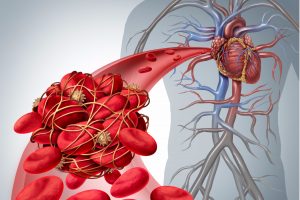I would never have guessed that Air France was out to kill me.
On the contrary I was feeling pleased with myself as I snuggled into my 777 Business Class seat for a routine daytime Beijing to Paris flight. The scheduled flight time of a shade under ten hours would be perfect for some well-deserved rest and relaxation at the expense of my employer.
As you may have gathered, I do not ‘do’ guilt when it comes to business travel. But that did not stop me from spending about half of the flight sitting upright and catching up with some work. From what I recall, I did not drink anywhere near enough water, slightly over indulged myself with the wine selection, snoozed for a couple of hours and, apart from one short visit to the ‘facilities’ did not move from my seat.

That little twinge of pain
As we landed at Paris Charles de Gaulle airport I was, let’s be honest, pleasantly sated. I was shuffling along the jet bridge to enter the terminal building when I was struck with what I took to be a mild cramping in my left calf. I knew the drill. Pausing to allow other passengers to pass, I leaned forward and raised my toes to stretch the muscles. To my consternation, there was no relief at all. After a moment, I hobbled in some discomfort into the terminal and managed to navigate my way through Immigration. What to do? Phone my wife! Judith’s professional training as a nurse would sort me out. She simply told me to ‘go and find a doctor.’ So, I did.
The medical centre was in a basement area with grey plastic wall panels, a low ceiling and bright fluorescent lighting. I joined a queue of around a dozen people, none of whom had the appearance of being at death’s door. A nurse was asking everyone in turn why they wanted medical help. When I explained my ailment, she disappeared, then quickly returned. ‘Follow me,’ she instructed. I hopped past the others, trying to avoid their collective gaze. I was ushered into the doctor’s consulting room and told to lie on the examination couch. The doctor probed my leg, asking questions about how I had spent the flight. Looking over the top of his glasses, he uttered the kind of sentence no one wants to hear. ‘I advise you to stay perfectly still, or you might die.’
The death threat sinks in
Well, he certainly had my full attention. Our discussion was in French, which slightly lessened the impact. But I got the message and held my breath. I did not count the number of injections he gave me over the next hour. In my dozy state, I vaguely remember being lifted onto a stretcher and wheeled into an ambulance. I cannot recall anything at all about the trip to hospital, or the admissions process. I do remember waking up on a stretcher at some point. How can I contact Judith? Is my suitcase still be sitting on the carousel back at the airport?
There was another big question in my mind. How is it possible for a Business Class passenger on a long-haul flight to be pitched so quickly from being cossetted in relative luxury to a sweaty, crowded and dimly lit corridor in a Parisian suburban hospital?
I spent countless hours slipping in and out of consciousness, and wondering what the hell was going to happen. To cut a long story short, I was eventually cut loose in the early hours of the following morning. I had a pocket full of drugs, and, surprisingly, my suitcase, which had been somehow located and transported to the hospital. I found a taxi and turned up at the Sheraton Hotel at Charles de Gaulle airport at around five o’clock in the morning. The desk clerk charged me the outrageous walk-up rate and I spent the next 12 hours sleeping. Nightmare over, although once back home in Toulouse I was to be grounded until my condition had stabilised.

How common is DVT?
I had been a suspected victim of the dreaded condition known as Deep Vein Thrombosis, or DVT. This is where a long period of immobility results in the formation of a blood clot in the vein which, if unleashed, may work its way to the heart or lungs with fatal consequences. My own experience was troublesome rather than worrying. I knew that I did not have a serious case of DVT. However, my interest in the condition was piqued. Had I escaped lightly?
To answer that question, I called up the doctor at Charles de Gaulle airport who had stopped me in my tracks with his bedside manner. To my surprise, he told me that DVT cases at the airport were not at all uncommon. This does not mean that sufferers always manage to struggle to his basement clinic. Rather, he explained, those struck with the condition often make it home without any undue effects. They may live quite normally for several weeks after their flight, unaware that a lethal blood clot is contained within their system. Then, quite suddenly, they drop dead. Charming.
When DVT hit the headlines
The first time that DVT in relation to airlines hit the headlines in a big way was in 2000, when a 28-year-old bride-to-be called Emma Christoffersen collapsed in the arrivals hall at Heathrow after a marathon flight from Sydney. She died in the ambulance shortly after. The papers jumped on the story and pointed the finger of guilt at the airlines for not providing adequate seating. DVT was presented as a killer disease. ‘Economy Class Syndrome’ was the moniker.
My own experience had involved a flight in Business Class. My French doctor explained that the condition may manifest itself after a long car journey, or even after sitting immobile in a cinema. We should not be so quick to point the finger at the airlines. They point out that the passengers are advised to exercise during the flight and drink plenty of water.
Exercise routines and drinking fluids does not change the reality that passengers are often packed in very tightly. In the UK, the minimum seat pitch is 28 inches, but seat manufacturers are touting 27 inches pitch where slim seat backs allow additional seats in the aircraft with no apparent reduction in comfort. High density seating raises the issue of whether an aircraft may be evacuated safely in an emergency. Egress from closely spaced seating is considered by passenger rights groups as being more difficult. The debate rages on.
Avoiding the issue
What else should passengers do to control the risk of contracting DVT? One imaginative tactic involved the development of the ‘knee defender’, a device that passengers would take on board to block seat recline. A United Airlines flight in September 2015 from Newark to Denver had to make an emergency landing in Chicago following a dispute between passengers over the use of a knee defender.
Senators and passenger user groups in the United States periodically attempt to push the Federal Aviation Administation to issue a moratorium on further shrinkage of passenger space. So far, these moves have been rebuffed. Certainly, the airlines’ own lobby groups, such as Airlines For America and IATA, consider that limits on seat sizes would work against the principals of competition and freedom of choice.
What does the medical profession think about DVT? An exhaustive study was carried out over a period of six years by the National Centre for Biotechnology Information, a US government funded resource. Their study of 8,755 employees of international organisations embraced 6,872 person-years (PY) of long-haul flying. A total of 53 thromboses were identified, of which 22 occurred within eight weeks of a long-haul flight. The incidence rate of 3.2/1,000 PY compares with an expected rate of 1.0/1,000 PY for non-flyers. This translates to a risk level of one event per 4,656 flights. The study concluded that the risk of thrombosis is increased by around two to four-fold after air travel, although the absolute risk cannot be established with certainty.

Ambulation will do the trick
A set of DVT guidelines were issued by the American College of Chest Physicians in 2012, noting that ‘frequent ambulation, calf muscle stretching, sitting in an aisle seat, and the wearing of compression stockings’ should be considered. The College concluded that travelling in Economy-class does not by itself increase the risk of developing a blood clot, although ‘remaining immobile for long periods of time will’.
Airlines do need to make efforts to counter the negative perception that DVT is linked to air travel. Pressure may mount for airlines to provide more circulating areas in the aircraft, which would likely influence seating density and, hence, aircraft economics.
I am sure you are wondering what long-term effect my brush with death has had on my life and career. Happily, none. One outcome was that I was prescribed a set of rather fetching compression stockings, much to the amusement of my Airbus colleagues.



















